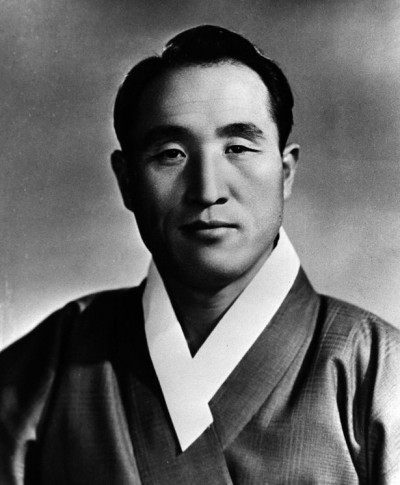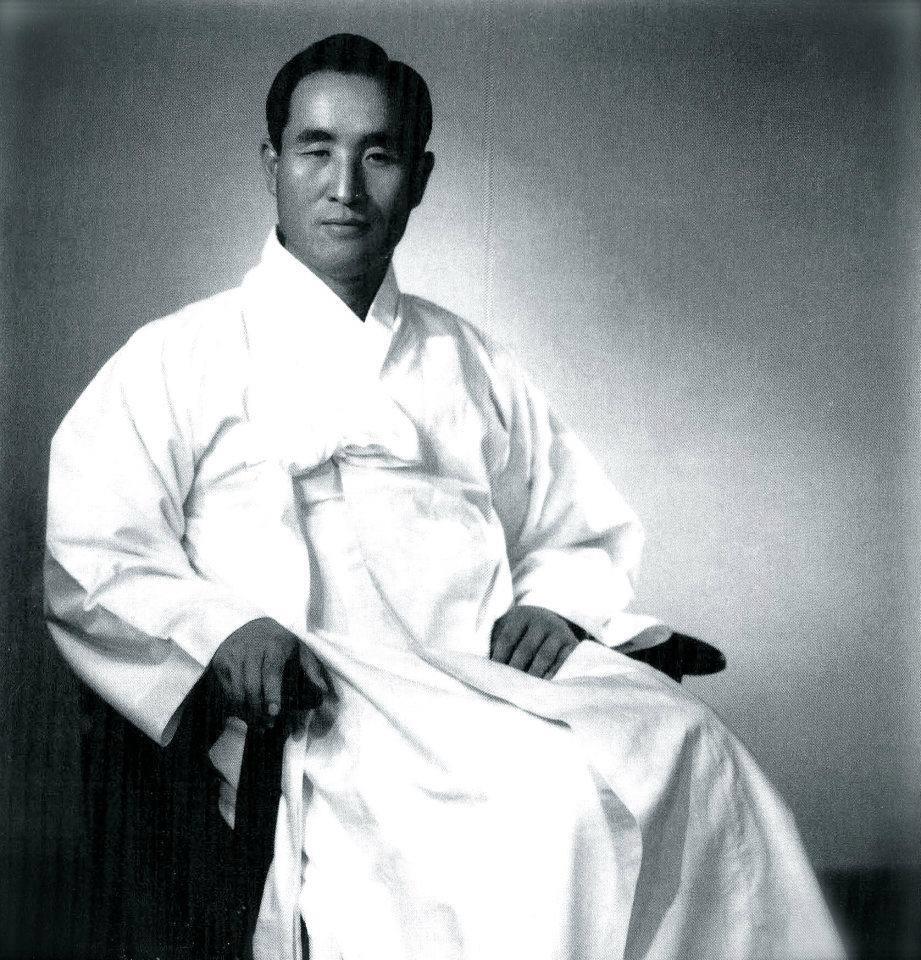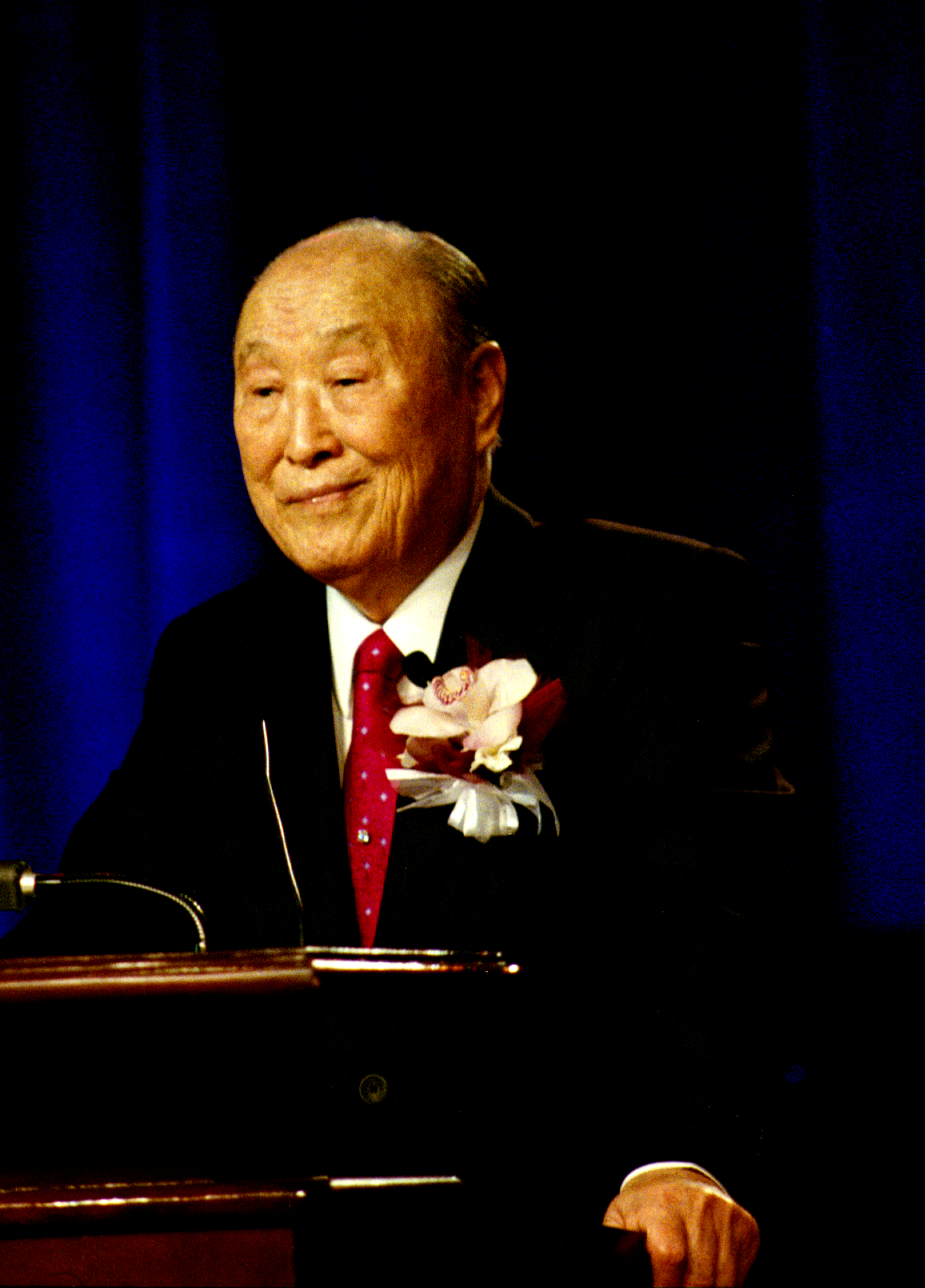Sun Myung Moon (Sun Myung Moon)

Sun Myung Moon was born Mun Yong-myeong on 25 February 1920, in modern-day North P’yŏng’an Province, North Korea, at a time when Korea was under Japanese rule. He was the younger of two sons in a farming family of eight children. Moon’s family rejected the Shinto faith pushed by the country’s Japanese rulers and followed Confucianist beliefs until he was around 10 years old, when they converted to Christianity and joined the Presbyterian Church. When he was 15, Moon said that Jesus Christ anointed him to carry out his unfinished work by becoming parent to all of humanity. In 1941, Moon began studying electrical engineering at Waseda University in Japan. During this time he cooperated with Communist Party members in the Korean independence movement against Imperial Japan. In 1943, he returned to Seoul and married Sun Kil Choi on 28 April 1945. On 2 April 1946 their son, Sung Jin Moon was born. Following World War II, Korea was divided along the 38th parallel into two trusteeships: the United States and the Soviet Union. Pyongyang was the center of Christian activity in Korea until 1945. From the late forties 166 priests and other religious figures were killed or disappeared in concentration camps, including Francis Hong Yong-ho, bishop of Pyongyang and all monks of Tokwon abbey. In 1947 Moon was convicted by the North Korean government of spying for South Korea and given a five-year sentence to the Hŭngnam labor camp. In 1950, during the Korean War he escaped and fled to Pusan, South Korea.
Moon emerged from his years in the labor camp as a staunch anti-communist. His teachings viewed the Cold War between democracy and communism as the final conflict between God and Satan, with divided Korea as its primary front line. At his new church, he preached a conservative, family-oriented value system and his interpretation of the Bible. In 1954, Moon formally founded the Unification Church as the “Holy Spirit Association for the Unification of World Christianity” in Seoul. He quickly drew young acolytes who helped to build the foundations of church affiliated business and cultural organizations. On 8 January 1957, Moon and Choi divorced.
The Divine Principle or Exposition of the Divine Principle (Korean 원리강론/原理講論, translit. wonli ganglon) is the main theological textbook of the Unification Church. It was co-written by Moon and early disciple Hyo Won Eu and first published in 1966. A translation entitled Divine Principle was published in English in 1973. The book lays out the core of Unification theology, and is held to have the status of scripture by believers. Following the format of systematic theology, it includes God’s purpose in creating human beings, the fall of man, and restoration – the process through history by which God is working to remove the ill effects of the fall and restore humanity back to the relationship and position that God originally intended. God is viewed as the creator, whose nature combines both masculinity and femininity, and is the source of all truth, beauty, and goodness. Human beings and the universe reflect God’s personality, nature, and purpose. “Give-and-take action” (reciprocal interaction) and “subject and object position” (initiator and responder) are “key interpretive concepts”, and the self is designed to be God’s object. The purpose of human existence is to return joy to God. The “four-position foundation” is “another important and interpretive concept”, and explains in part the emphasis on the family.
The Divine Principle was labeled as heretical by Protestant churches in South Korea, including Moon’s own Presbyterian Church. In the United States it was rejected by ecumenical organizations as being non-Christian, especially because of its addition of material to the Bible and for its rejection of a literal Second Coming of Jesus. Protestant commentators have also criticized Unification Church teachings as being contrary to the Protestant doctrine of salvation by faith alone. In their influential book The Kingdom of the Cults (first published in 1965), Walter Ralston Martin and Ravi K. Zacharias disagreed with the Divine Principle on the issues of the divinity of Christ, the virgin birth of Jesus, the Unification Church’s belief that Jesus should have married, the necessity of the crucifixion of Jesus, and a literal resurrection of Jesus as well as a literal second coming of Jesus. Commentators have criticized the Divine Principle for saying that the First World War, the Second World War, the Holocaust, and the Cold War served as indemnity conditions to prepare the world for the establishment of the Kingdom of God.
Moon has said that Jesus called upon him to carry out his unfinished work, including his failure to marry. Jesus was divine but not God; he was supposed to be the second Adam who would create a perfect family by joining with the ideal wife and creating a pure family that would have begun humanity’s liberation from its sinful condition. When Jesus was crucified before marrying, he redeemed mankind spiritually but not physically. That task was left to the “True Parents” – Moon and Han – who would link married couples and their families to God. Moon married his second wife, Hak Ja Han, on 11 April 1960, soon after she turned 17 years old, in a ceremony called the Holy Marriage. Han is called “Mother” or “True Mother”. She and Moon together are referred to as the “True Parents” by members of the Unification Church and their family as the “True Family”.
Moon was renowned for presiding over mass “blessing ceremonies”, the most famous ritual of the Unification Church. In church doctrine, ceremony removes couples from the lineage of sinful humanity and grafts them into God’s sinless lineage. Blessing ceremonies have attracted a lot of attention in the press and in the public imagination, often being labeled “mass weddings”. However, in most cases the Blessing ceremony is not a legal wedding ceremony. Some couples are already married and those that are engaged are later legally married according to the laws of their own countries. Meant to highlight the church’s emphasis on traditional morality, they brought Moon both fame and notoriety. 36 couples participated in the first ceremony in 1961 for members of the early church in Seoul, South Korea. The ceremonies continued to grow in scale; over 2,000 couples participated in the 1982 one at New York’s Madison Square Garden, the first outside South Korea. In 1997, about 30,000 couples took part in a ceremony in Washington, DC. Moon matched couples from differing races and nationalities as part of his belief that all of humanity should be united: “International and intercultural marriages are the quickest way to bring about an ideal world of peace. People should marry across national and cultural boundaries with people from countries they consider to be their enemies so that the world of peace can come that much more quickly.”
In 1971, Moon moved to the United States, which he had first visited in 1965. He remained a citizen of the Republic of Korea and maintained a residence in South Korea. In 1972, Moon founded the International Conference on the Unity of the Sciences, a series of scientific conferences. The first conference had 20 participants, while the largest conference in Seoul in 1982, had 808 participants from over 100 countries. Participants included Nobel laureates John Eccles (Physiology or Medicine 1963, who chaired the 1976 conference), Eugene Wigner (Physics 1963). In 1974, Moon asked church members in the United States to support President Richard Nixon during the Watergate scandal when Nixon was being pressured to resign his office. Church members prayed and fasted in support of Nixon for three days in front of the United States Capitol, under the motto: “Forgive, Love and Unite.” On 1 February 1974 Nixon publicly thanked them for their support and officially received Moon. This brought the church into widespread public and media attention. In the 1970s, Moon, who had seldom before spoken to the general public, gave a series of public speeches to audiences in the United States, Japan, and South Korea. The largest were a rally in 1975 against North Korean aggression in Seoul and a speech at an event organized by the Unification Church in Washington D.C.
In 1982, Moon was convicted in the United States of filing false federal income tax returns and conspiracy. His conviction was upheld on appeal in a split decision. Moon was given an 18-month sentence and a $15,000 fine. He served 13 months of the sentence at the Federal Correctional Institution, Danbury before being released on good behavior to a halfway house. The case was the center of national freedom of religion and free speech debates. Prof. Laurence H. Tribe of the Harvard University Law School argued that the trial by jury had “doomed (Moon) to conviction based on religious prejudice.” The American Baptist Churches in the U.S.A, the National Council of Churches, the National Black Catholic Clergy Caucus, and the Southern Christian Leadership Conference filed briefs in support of Moon. Many notable clergy, including Jerry Falwell and Joseph Lowery, signed petitions protesting the government’s case and spoke out in defense of Moon.
In 1982 The Washington Times was founded by News World Communications, an international media conglomerate associated with Moon which also owns newspapers in South Korea, Japan, and South America, as well as the news agency United Press International. The political views of The Washington Times have often been described as conservative. The Times is read by Washington DC insiders (most of whom also read the more successful Washington Post), notably Ronald Reagan, but has never been a financial success. By 2002 Moon had invested roughly $1.7 billion to support the Times, which he called “the instrument in spreading the truth about God to the world”.
In 2000, Moon sponsored a United Nations conference which proposed the formation of “a religious assembly, or council of religious representatives, within the structure of the United Nations.” In 2001, Moon came into conflict with the Roman Catholic Church when Catholic archbishop Emmanuel Milingo and Maria Sung, a 43-year-old Korean acupuncturist, married in a Unification Church Blessing ceremony, presided over by Moon and Han. Following his marriage the Archbishop was called to the Vatican by Pope John Paul II, where he was asked not to see his wife anymore, and to move to a Capuchin monastery. Sung went on a hunger strike to protest their separation. This attracted much media attention. Milingo is now an advocate of the removal of the requirement for celibacy by priests in the Catholic Church. He is the founder of Married Priests Now!. In 2003, Moon sponsored the first Peace Cup international club football tournament. The Los Angeles Galaxy, which competes in Major League Soccer, played in South Korea in the Peace Cup. During the event Pelé, widely regarded as the best soccer player of all time and former Brazilian Sports Minister, met with Moon.
In 2003, George D. Chryssides of the University of Wolverhampton criticized Moon for introducing doctrines which tended to divide the Christian church rather than uniting it, which was his stated purpose in founding the Unification Church (originally named the Holy Spirit Association for the Unification of World Christianity). In April 2008, Moon appointed his youngest son, Hyung Jin Moon, to be the new leader of the Unification Church and the worldwide Unification Movement, saying, “I hope everyone helps him so that he may fulfil his duty as the successor of the True Parents.” In 2009, Moon’s autobiography, As a Peace-Loving Global Citizen (Korean: 평화를 사랑하는 세계인으로), was published by Gimm-Young Publishers in South Korea. The book became a best-seller in Korea and Japan. By 2010, Moon had given much of the responsibility for the Unification Church’s religious and business activities to his children, who were then in their 30s and 40s. In 2012, the South Korean press reported that Moon traveled worldwide in his private jet which cost $50 million.
On 14 August 2012, after suffering from pneumonia earlier in the month, Moon was admitted to Saint Mary’s Hospital at The Catholic University of Korea in Seoul. On 15 August 2012, he was reported to be gravely ill and was put on a respirator at the intensive care unit of St. Mary’s Hospital. On 31 August 2012, Moon was transferred to a church-owned hospital near his home in Gapyeong, northeast of Seoul, after suffering multiple organ failure. Moon died on the morning of 3 September 2012 (1:54 am KST) at the age of 92.
Born
- February, 25, 1920
- Jeong-ju, North P'yŏng'an, Japanese Korea
Died
- September, 03, 2012
- Gapyeong, South Korea
Cause of Death
- multiple organ failure
Cemetery
- Buried at his home
- Cheongseung Mountain, South Korea



